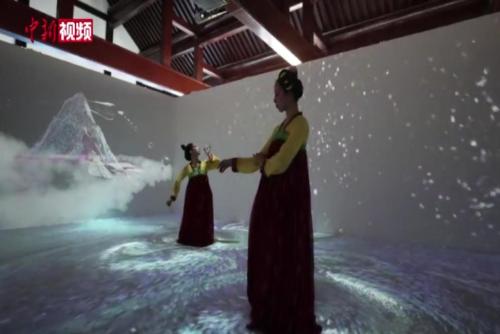China News Network Beijing, May 14 (Reporter Sun Zifa) The National Astronomical Observatory of the Chinese Academy of Sciences announced to the media on May 14 that Dr. Xu Jun and researcher Han Jinlin of the observatory, by analyzing the distribution data of pulsars in the Milky Way and the Faraday rotation effect of radio sources outside the Milky Way, found that there is a huge magnetic ring structure in the halo (silver halo) of the Milky Way, Its magnetic ring extends from 6000 light years to 50000 light years from the center of the Milky Way Galaxy.
The structure of giant magnetic rings in the halo of the Milky Way Galaxy. National Astronomical Observatory of Chinese Academy of Sciences
This landmark research paper on the Milky Way's magnetic field by Chinese scientists has recently been published in the international scientific journal Astrophysical Journal (ApJ), providing crucial observation results for research fields such as cosmic ray particle propagation, galactic gas dynamics and cosmic magnetic field evolution.
Xu Jun, the first author of the paper, said that the origin and evolution of the cosmic magnetic field is a long-term outstanding major problem in astrophysics, and it is also a priority project for many large radio telescope projects, such as the Square Kilometer Array Radio Telescope (SKA). They are developing and improving polarization measurement capabilities, hoping to make efforts in this direction.
Among them, measuring the large-scale magnetic field structure of the Milky Way is a challenging task. Researcher Han Jinlin, who has pioneered this research field, has been deeply engaged in the study of the magnetic field in the Milky Way for the past 30 years. He measured the large-scale magnetic field structure in the galactic disk (silver disk) by observing the Faraday rotation effect of a large number of pulsars and extragalactic radio sources, and found that the direction of the large-scale magnetic field in the silver disk is along the spiral arms and turns between the spiral arms.
In the silver halo area, Han Jinlin and others took the lead in certifying that Faraday rotation effect has an antisymmetric symbol distribution in the inner galactic sky as early as 1997, indicating that the silver halo above and below the silver disk has an annular magnetic field structure in opposite directions, which was subsequently confirmed by more astronomical observation data, widely adopted by the international astronomical community, and became the basic content of the galactic magnetic field structure model, It has also been written into many international classic textbooks.
Han Jinlin, the corresponding author of the paper, pointed out that the size and strength of the silver halo magnetic ring structure have been difficult to measure for more than 20 years, because pulsars and other celestial bodies in the silver halo region near the sun also show the antisymmetric distribution of the Faraday effect. Some international scholars speculate whether the Faraday antisymmetric sky is dominated by the interstellar medium in the local region of the Milky Way near the sun. "So, does this magnetic ring exist in the whole silver halo or only in local areas? What is the strength and size of the silver halo magnetic ring?"
To solve these problems, Han Jinlin innovatively proposed in this study that the Faraday rotation measurement of pulsars near the sun is taken as the contribution of local interstellar media and deducted from the Faraday effect sky distribution of extragalactic radio sources, so that the Faraday rotation effect distribution of giant silver halos can be obtained. Xu Jun collected all relevant data, and with the help of the 500m aperture spherical radio telescope (FAST), which is known as the "Chinese Celestial Eye", he newly measured many data of dark weak pulse stars.
After analyzing the data according to this innovative idea, they found that the average Faraday effect of all the sky showed an antisymmetric distribution of galactic coordinates, and the antisymmetric distribution was no longer limited to the inner galactic region, but filled all the sky, extending from the central region of the Milky Way to its opposite direction. This research result shows that the magnetic ring in the silver halo extends from 6000 light years away from the silver center to 50000 light years (the sun is about 30000 light years away). The interstellar medium in the local area near the sun is obviously a part of the huge magnetic ring, and its basic properties and characterization are basically consistent with that of the big magnetic ring, but its effect is stronger because it goes deep into the silver disk.
"I had this idea more than 20 years ago. I have been slowly accumulating data and finally got it," said Han Jinlin. (End)































































